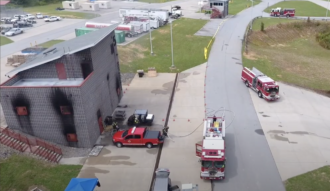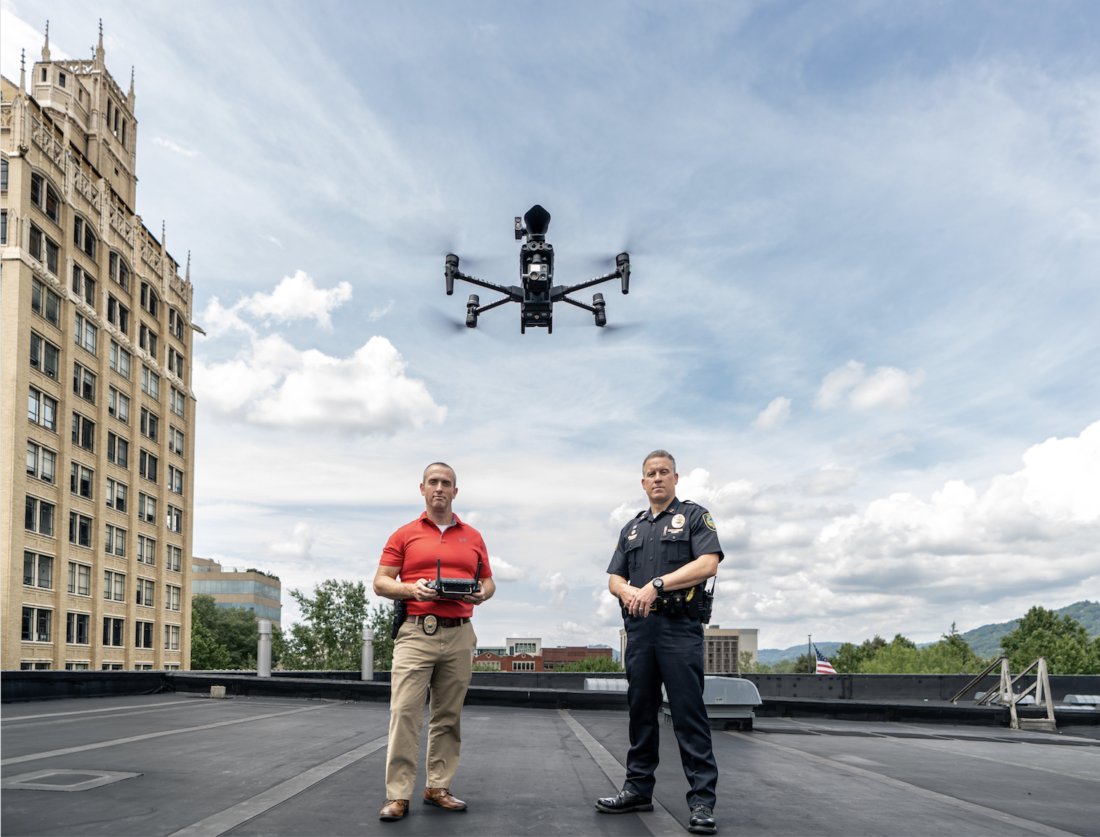Most people are accustomed to a police presence at large public events like Asheville’s July Fourth celebration. This year it was a little different. In addition to uniformed officers on the pavement, drones from the city’s police and fire departments hovered around the crowd.
Police and fire are the only city departments to own drones: The Asheville Fire Department has four, and the Asheville Police Department has seven. (Several departments in Buncombe County also own drones, like the Planning and Development Department.)
APD says drones can be a force multiplier for the department, which is understaffed. However, privacy experts warn that the usage of such technology by the government needs to be proactively curtailed.
“It’s important that we don’t sleepwalk into a world of widespread aerial surveillance, that communities think very carefully about whether they want drone surveillance, and, if they decide to permit some operations, put in place guardrails that will prevent those operations from expanding,” writes Jay Stanley, speech, privacy and technology project senior policy analyst for the American Civil Liberties Union, in a July 27 paper titled “Eye-in-the-Sky Policing Needs Strict Limits.” [Read more at avl.mx/cvy.]
Drones as first responders
The city police and fire departments say their drones are meant to supplement first responders and “allow us to get eyes on a scene, sometimes within 30 seconds, whereas our patrolmen response would be several minutes,” says APD Capt. Brandon Moore. The city’s most sophisticated drones can be streamed in real time via an app by individuals with access. For example, during the city’s Fourth of July festivities, APD Sgt. Chris Byers flew a drone, and Moore, who was not on call that day, logged in to watch what the aircraft saw in real time.
Moore says sending a drone to a call for service relieves pressure on APD by enabling officers to immediately adjust the size of a response, based on real-time information from the drone.
Moore recounted an instance in which APD sent a drone ahead of officers to survey an apartment where an assault suspect was barricaded. The drone showed officers what they’d encounter when approaching the residence. The technology continued to record the scene once APD arrived. “Then the drone stayed on what we call an overwatch and continued to record the entire scene as [officers] approached the door and made contact,” Moore explains. The suspect eventually came out and surrendered.
Jeremy Knighton, AFD’s division chief of emergency management, describes his department’s drone deployments as “very mission specific.” He says AFD has used drones several times to look for missing persons. “We’re able to get a bird’s-eye view, literally,” he says. Drones can cover a grid more quickly than people and take photographs of the ground while searching.
Additionally, the Fire Department has used drones to analyze fires and plot approaches. Knighton describes a fire where an infrared lens in the drone provided thermal imaging to pinpoint the location of the blaze.
Drones used by government agencies are more expensive and include more sophisticated features than so-called hobby drones.
When flying a type of drone called the Avata, for example, an APD officer wears goggles that show what the drone “sees,” and he navigates the aircraft using head movements. Moore says this drone is deployed for tactical use, such as for the APD bomb unit, Emergency Response Team (also known as the SWAT team) or the crisis negotiation unit.
Another drone called the Matrice 30 has a camera that can zoom in to a magnification of 200, provide a wide-angle panorama and conduct thermal imaging. The device’s low-light camera also captures clear pictures in dark settings, according to the company’s video.
The city purchased APD’s drones last summer and began using the technology in the fall, says Moore.
Surveillance in the city and county
Unmanned aircraft systems are not the first example of surveillance in Asheville or Buncombe County. The Buncombe County Sheriff’s Office owns and operates cameras linked to a system called Fusus Unified Intelligence Platform, which provides real-time surveillance. According to previous Xpress reporting, a majority of the cameras are on county-owned property with some on downtown businesses, such as the Miles Building.
Under the APD’s drone policy, which can be viewed at avl.mx/cv5, the city will record each flight mission, flight data and keep an accumulative flight log. Deployments have to be approved by the program coordinator, watch commander or shift chief. The drones also can’t intentionally record or transmit images of any location where a person would have a reasonable expectation of privacy such as residence, yard or enclosure. Furthermore, drones can’t look into buildings unless part of a search warrant.
APD’s drones do not have facial recognition software, but such a capability exists for the technology, Moore tells Xpress.
State law dictates that APD must “purge” the data after 90 days unless it is being used for a criminal case, Moore says. This law applies to body cameras, in-vehicle cameras and regular cameras; a judge’s order is required for the footage to be released.
Stanley from the ACLU says it’s a positive sign that APD’s drone policy is publicly available. However, he continues, a general concern around drone use is the eventual expansion of a policy over time to become routine, suspicionless aerial surveillance of the public.
Nationwide, the ACLU supports drone policies that place limits on use, provide transparency on their use in the form of a publicly available flight log, prevent data from being retained longer than necessary and require private-sector vendors who are part of the drone program to follow the same policies as the department using it, according to Stanley’s paper.
Moore was adamant that APD’s drone policy offers adequate privacy protections for the public and isn’t “designed to … just throw things in the air to do surveillance on the unknowing public,” he tells Xpress.
Adds Byers, “We have not deployed it in covert surveillance or anything like that.”
Flight safety
Not all concerns about drones are related to surveillance; some relate to air traffic safety. Fifteen members of APD and 11 members of AFD earned certification from the Federal Aviation Administration, plus additional training.

Drones can’t fly higher than 400 feet, and a pilot must have a visual observer to watch the sky and ensure the drone doesn’t impede other aircraft, Moore says.
APD is far enough away from Asheville Regional Airport that drones aren’t in its airspace. It does contact the airport if it plans to use a drone nearby, such as with a missing person, Moore says. APD also shares airspace with Mission Health’s Mountain Area Medical Airlift, and it informs MAMA when drones are in the air because helicopter pilots can’t see them.
Only one APD drone has suffered an incident: a bird attack. “We don’t know [what kind of bird], but it was large because it took out almost every propeller on [the drone],” Moore says.
The pilot landed the drone safely, and later its microphone and spotlight had to be replaced. “We never found the bird.”



Looks like a great addition to the department. This will enable quicker responses to accidents, fires and other emergencies, enabling the right responses instead of wasting resources and personnel time. All the people worried about surveillance should quit doing whatever it is they are concerned about.